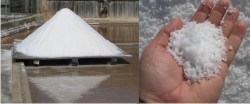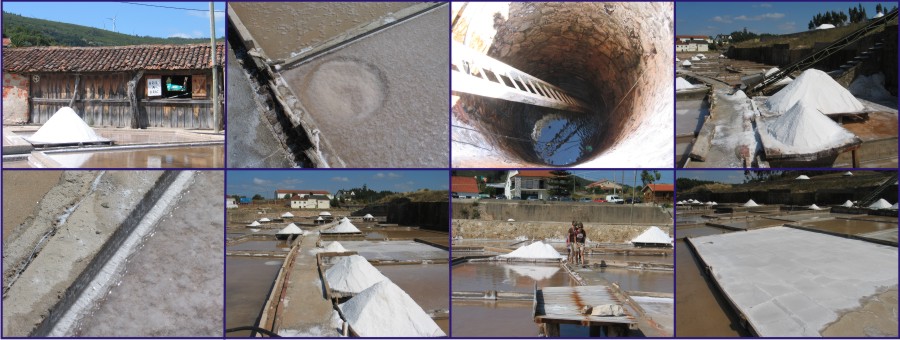
From the guidelines, as from January 2013"People do not need to wait for permission to log your EarthCache. Requiring someone to wait is not supported by the EarthCache guidelines. People should send their logging task answers to you, then log your EarthCache. When you review their logging task answers, if there is a problem, you should contact them to resolve it. If there is no problem, then their log simply stands."

Halite, better known as rock salt, can easily be distinguished by its taste.  Since taste is an important property of salt, there is a right way to taste a specimen of halite (or an unknown mineral that is similar to halite) and a wrong way. The right way is to first lick your index finger, rub it against the specimen and then taste the finger. This limits the amount of the mineral that actually gets in your mouth, an important consideration when you consider that there are poisonous minerals that resemble halite.
Since taste is an important property of salt, there is a right way to taste a specimen of halite (or an unknown mineral that is similar to halite) and a wrong way. The right way is to first lick your index finger, rub it against the specimen and then taste the finger. This limits the amount of the mineral that actually gets in your mouth, an important consideration when you consider that there are poisonous minerals that resemble halite.
Occurrence:
Halite occurs in vast beds of sedimentary evaporite minerals that result from the drying up of enclosed lakes, playas, and seas. Salt beds may be up to 405 meters thick and underlie broad areas.
Salt domes are vertical diapirs or pipe-like masses of salt that have been essentially "squeezed up" from underlying salt beds by mobilization due to the weight of overlying rock. Salt domes contain anhydrite, gypsum, and native sulfur, in addition to halite and sylvite. They are common along the Gulf coasts of Texas and Louisiana and are often associated with petroleum deposits. Germany, Spain, Portugal, the Netherlands, Romania and Iran also have salt domes. In Portugal salt domes are also currently being used to store natural gas.
Uses:
Halite is often used both residentially and municipally for managing ice. Because saline (a solution of water and salt) has a lower freezing point than ordinary water, putting salt on ice will cause it to melt. It is common for homeowners in cold climates to spread 'rock salt' on their walkways and sometimes driveways after a snow storm to melt the ice. It is not necessary to use so much salt that the ice is completely melted; rather, a small amount of salt will weaken the ice so that it can be easily removed with other means. Also, many cities will spread a mixture of sand and salt on roads during and after a snowstorm to improve traction.
Rock salt is also used to make ice cream. It is not actually used in the ice cream mixture; rather, it is used to melt the ice surrounding the can holding the ice cream, causing the ice to melt at a lower temperature, thus lowering the temperature of the ice bath and quickening the freezing process.
The Rio Maior Marinhas (Salt pans)
The Rio Maior Salt Pans (“Marinhas de Sal“) are a natural phenomenon, far away from the sea (30 km), and one of the most important treasures of the region. The salt pans still produce today and have done so for at least the last 900 years and were already explored by the Romans and Moors.
The brine from this spring, seven times more salty than sea water, is pumped into square pans where it is left to evaporate. The salt is collected by hand and piled next to each pan on a wooden table.
The salt is sold locally to visitors at about 30 cents a kilogram.
In the region the importance of these salt pans is such that they even feature in the Rio Maior coat of arms. Surrounding the salt pans is a tiny village made of wooden and stone houses (to prevent corrosion).

The cache
Go to the coordinates supplied and tell me who collaborated in the inauguration of the tiny village and on what date did it take place. Additionally you have to send me the measurements (L x W) of one of the evaporation pans.
Send me the answer via e-mail to validate the found.
NO tell-tale photos in the logs.
Have fun!

Halite ou cloreto de sódio, popularmente conhecido como sal ou sal de cozinha, é uma substância largamente utilizada formada por um átomo de Cloro e um átomo de Sódio. A sua fórmula química é NaCl. Actualmente é produzido pela evaporação da água do mar ou vindo de outras fontes como lagos de sal ou pedras de sal.
Embora a maioria das pessoas esteja familiarizada com os vários usos do sal na culinária, desconhece que a substância é utilizada em várias outras aplicações, como a manufactura de papel e a produção de sabão e detergentes.
No norte dos Estados Unidos da América e na Europa, grandes quantidades de sal são utilizadas para limpar as rodovias do gelo durante o Inverno.
As salinas naturais de Rio Maior constituem um dos principais referenciais da localidade e são um orgulho para Rio Maior, por serem as únicas do género em Portugal ainda em exploração. Estas salinas estão consideradas como Imóvel de Interesse Público, no contexto do património cultural português. É assim que, do antiquíssimo poço das Marinhas do Sal, brota água salgada que abastece os 400 talhos, ou compartimentos, e os 70 esgoteiros, que ocupam 21865 m2.
A água desta nascente é sete vezes mais salgada que a água do mar, e era retirada com a ajuda de duas enormes Picotas ou "Cegonhas" há bem pouco tempo. Estes engenhos são um legado árabe com certeza, pois foram estes que os introduziram na Europa. Aliás, é de crer que os romanos, e depois os árabes, tenham explorado em grande escala estas salinas.
Aqui podem ser apreciadas as pirâmides de sal e todo o conjunto de casas típicas de madeira, que fazem das salinas naturais um museu vivo com quase novecentos anos. Recomenda-se a sua visita durante os meses de verão, pois só nessa altura é possível a formação dos cristais de sal.
 Há referências às salinas de Rio Maior desde 1177, em documentos escritos que são aliás os mais antigos sobre Rio Maior. Sabe-se também que D. Afonso V era proprietário de cinco talhos nas salinas de Rio Maior no século XV, e que recebia um quarto de toda a produção, tendo o monopólio da sua venda. A importância económica das salinas para a região, está bem vincada nas duas pirâmides de sal retratadas no Brasão da cidade de Rio Maior.
Há referências às salinas de Rio Maior desde 1177, em documentos escritos que são aliás os mais antigos sobre Rio Maior. Sabe-se também que D. Afonso V era proprietário de cinco talhos nas salinas de Rio Maior no século XV, e que recebia um quarto de toda a produção, tendo o monopólio da sua venda. A importância económica das salinas para a região, está bem vincada nas duas pirâmides de sal retratadas no Brasão da cidade de Rio Maior.
Estas salinas são únicas no país e são fruto de uma maravilha da natureza. A água salgada provém de uma extensa e profunda mina de sal-gema, que é atravessada por uma corrente subterrânea de água doce, que se torna depois salgada. Trata-se de sal puro (97,94% de cloreto de sódio), que é recolhido nos talhos pelos marinheiros (designação dada aos salineiros). O poço tem 9 metros de profundidade e 3,75 de diâmetro e a distribuição da água pelos talhos obedece a regras consuetudinárias de origem ancestral.
As salinas estão divididas em compartimentos de diversos tamanhos, a que se chama talhos. Estes são feitos em cimento ou pedra e têm pouca profundidade. Actualmente a água salgada é retirada do poço por meio de um motor, sendo posteriormente distribuida pelos talhos, através de regueiras. Os estreitos carreiros que separam os talhos, servem para os marinheiros circularem entre os compartimentos, e denominam-se baratas. Para além destes talhos existem os esgoteiros, onde é colocada a água salgada para mais tarde ser distribuída pelos talhos. Para o processo de secagem estar completo, o sal é colocado em eiras, sendo posteriormente transportado para as velhas casas de madeira, onde é conservado e vendido. No local, em algumas dessas típicas casas de madeira, há uma série de cafés, restaurantes e lojas de artesanto, que constituem o suporte turístico deste autêntico museu vivo.

A cache:
Nas coordenadas indicadas encontrarão informação que responde às seguintes perguntas:
1- Quem colaborou na inauguração da aldeia típica das salinas? e 2- em que data foi? Adicionalmente a estas duas questões quero saber quais as medidas de um dos talhos. Enviem-me as respostas por mail para validar o vosso found.
Nada de fotos reveladoras nos logs!
Divirtam-se!

 The most exciting way to learn about the Earth and its processes is to get into the outdoors and experience it first-hand. Visiting an Earthcache is a great outdoor activity the whole family can enjoy. An Earthcache is a special place that people can visit to learn about a unique geoscience feature or aspect of our Earth. Earthcaches include a set of educational notes and the details about where to find the location (latitude and longitude). Visitors to Earthcaches can see how our planet has been shaped by geological processes, how we manage the resources and how scientists gather evidence to learn about the Earth. To find out more click HERE.
The most exciting way to learn about the Earth and its processes is to get into the outdoors and experience it first-hand. Visiting an Earthcache is a great outdoor activity the whole family can enjoy. An Earthcache is a special place that people can visit to learn about a unique geoscience feature or aspect of our Earth. Earthcaches include a set of educational notes and the details about where to find the location (latitude and longitude). Visitors to Earthcaches can see how our planet has been shaped by geological processes, how we manage the resources and how scientists gather evidence to learn about the Earth. To find out more click HERE.
